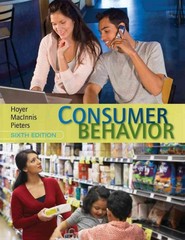8. When is affect likely to be more of a factor in low-effort decision making? This chapter...
Question:
8. When is affect likely to be more of a factor in low-effort decision making? This chapter examines the nature of consumer judgment and decision making when motivation, ability, and opportunity—
and consequently elaboration—are low. In these situations, consumers often make judgments using simplified heuristics or decision rules. When using the representativeness heuristic, consumers base their judgments on comparisons to a category prototype. When using the availability heuristic, they base their judgments on accessibility of information.
Sometimes low-effort decisions are made unconsciously, sometimes consciously. Unconscious decisions may be strongly affected by environmental cues. Conscious low-effort decision making can follow a hierarchy of effects in which thinking leads to behaving and results in feeling; in contrast, the hierarchy of effects for high-effort decision making is typically thinking-feeling-behaving. For simplicity, consumers making low-effort decisions may satisfice rather than optimize. They may also devise choice tactics over repeat purchase occasions through a process similar to operant conditioning. Cognitively based choice tactics include performance, habit, brand loyalty, price, and normative influences; affective-based choice tactics include affect referral, brand familiarity, variety seeking, and impulse buying.
Step by Step Answer:

Consumer Behavior
ISBN: 9781133435211
6th Edition
Authors: Wayne D Hoyer, Deborah J Macinnis, Rik Pieters






